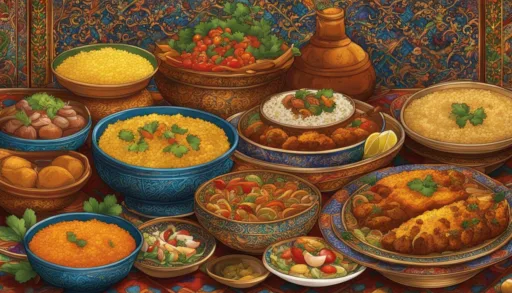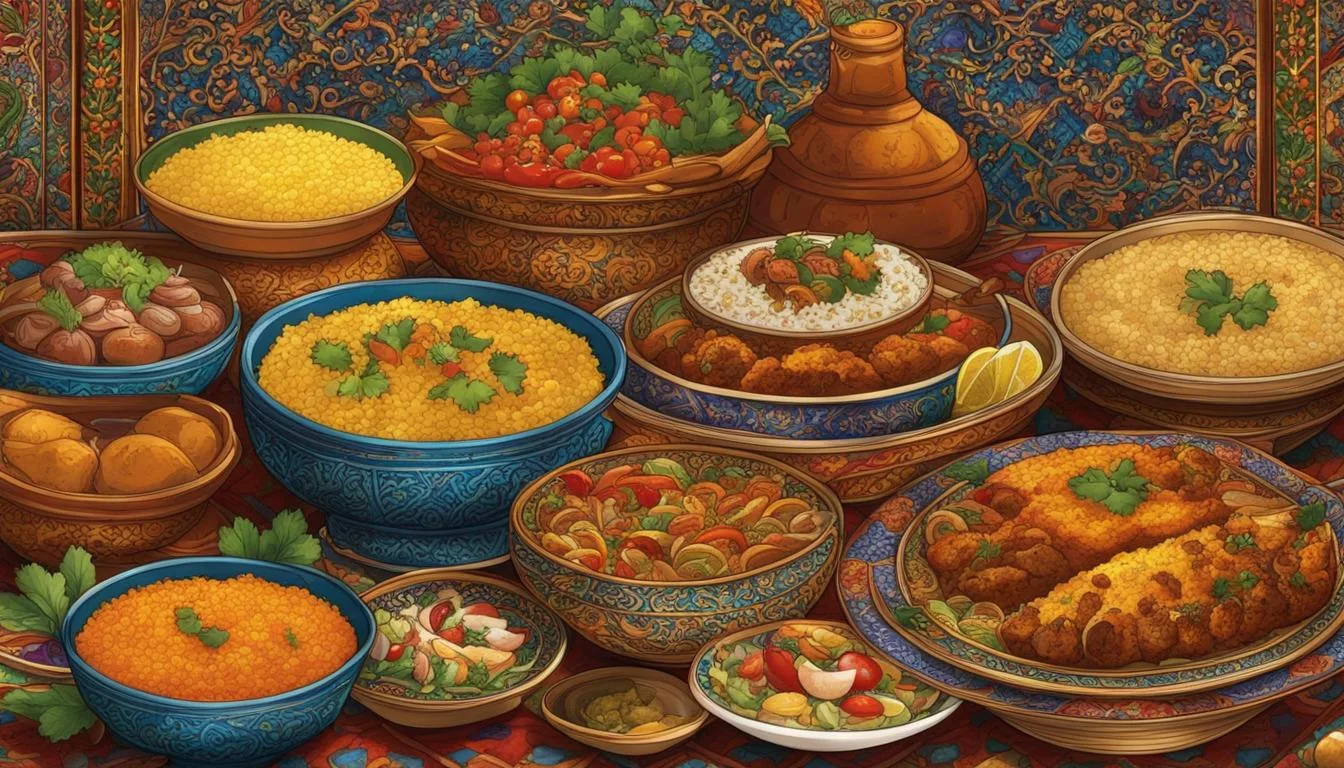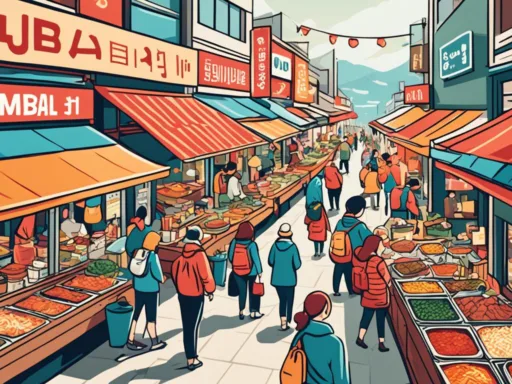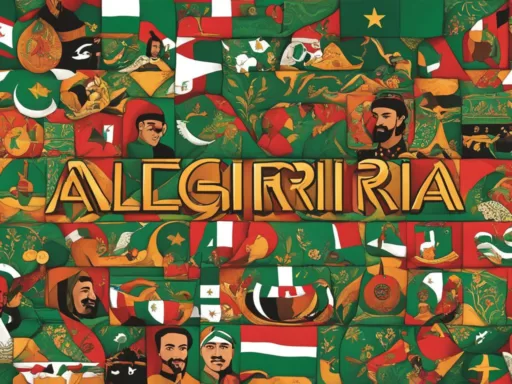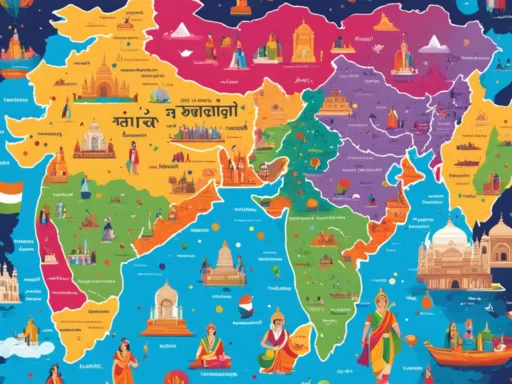In a country where recipes date back over a millennium, Iran’s culinary scene continues to thrive, influencing and delighting taste buds globally. With an estimated 2500 traditional dishes, Iranian cuisine presents an eclectic feast for the senses, beckoning travelers and cuisine connoisseurs to explore its vast gastronomic landscape. This Iranian Culinary Guide ventures deep into the heart of Persian food recipes, touring the traditional Iranian dishes that echo the past and resonate with the vivid flavors of a proud and varied heritage. Join us on this Persian cuisine exploration, where every dish tells a story and every flavor invites you to experience the richness of Iran’s culture through its food.
Key Takeaways
- Iran boasts a staggering array of over 2500 traditional dishes, underscoring its complex culinary history.
- Traditional Iranian dishes offer a window into the nation’s culture, reflecting millennia of culinary refinement.
- Embarking on a Persian cuisine exploration is tantamount to a historical journey flavored with ancient traditions.
- Persian food recipes blend a tapestry of spices, herbs, and fresh ingredients that promise an unforgettable culinary experience.
- An Iranian Culinary Guide provides insight into understanding and appreciating Iran’s diverse and flavor-packed gastronomy.
The Cultural Significance of Food in Iran
Delving into the heart of Iranian culinary traditions reveals a vibrant tapestry of social customs and communal ethos, where food is much more than mere nourishment. It’s an art form, a language of love and hospitality that threads through every Persian gathering. Traditional Iranian dishes, steeped in history and enriched with diverse Iranian cooking techniques, serve not only to satiate hunger but to bind communities, celebrate joyous occasions, and honor the past.
In Iran, every meal is a mosaic of flavors and aromas, designed to encourage dialogue and deepen relationships. Known for its distinctive use of herbs and spices, Iranian cuisine is a testament to the nation’s creative and intricate cooking techniques. Methods like slow-cooking, grilling, and baking are not just about preparing food; they are woven into the fabric of daily life, ensuring that each dish speaks of generosity and community.
From elaborate wedding feasts to intimate family dinners, the spirit of sharing and hospitality—embodied in the practice of Ta’arof—is always present, creating an atmosphere of warmth, respect, and affinity.
- The centrality of communal dining arrangements
- Festive celebrations marked by an array of traditional Iranian dishes
- Daily rituals that celebrate unity through the shared experience of a meal
These culinary practices are not just about the food; they’re a way of living, a reflection of cultural values that cherish bringing people together, be it a grand occasion or an everyday family meal. To partake in the culinary delights of Iran is to immerse oneself in a culture that richly values its heritage, where every bite tells a story etched deep within the heart of its people.
An Iranian Culinary Guide: The Tapestry of Flavors
Embarking on a Persian cuisine exploration offers a sensory encounter with the subtle and rich tapestries created by Persian kitchen ingredients. Iranian food recipes are not merely about sustenance; they narrate stories of tradition, culture, and the land’s bounty. The core of this culinary journey lies in understanding the fundamental elements that constitute the base of Traditional Iranian dishes and the philosophies that guide their creation.
The Role of Aromatics and Spices in Persian Recipes
In the realm of Persian food recipes, the mastery of flavor lies in the incorporation of a distinctive array of spices and herbs. These aromatic elements serve as the linchpin in presenting the depth and complexity for which the Persian culinary guide is renowned. Ingredients such as saffron, known for its vivid crimson strands and earthy undertones, and cumin, with its potent, warm flavor, form the cornerstone of many a dish, elevating the gastronomic experience to new heights.
Foundational Ingredients Central to Iranian Cooking
The Persian kitchen is an intricate dance of elements, bringing together staple ingredients pivotal to the cuisine’s character. Grains such as basmati rice soar in dishes like Chelow, while Zereshk Polo provides a tangy encounter with barberries. Meats, particularly lamb, symbolize the richness of the land, skewered into Kebabs or simmered in stews like Fesenjan, redolent with the nuttiness of walnuts and the sour zest of pomegranates. Extracted from the various provinces and the heart of Iranian culture, these ingredients interlace to form a portrait of Iranian Culinary Guide.
Understanding the Hot and Cold Nature of Persian Ingredients
The ancient wisdom of Avicenna still breathes life into the Iranian culinary guide, influencing how ingredients are understood and utilized. The concept of hot (Garm) and cold (Sard) natures plays a pivotal role, guiding the balance of dishes to create harmony within the body. A dish might feature a so-called ‘cold’ ingredient like eggplants paired with ‘hot’ ones such as walnuts to strike equilibrium, both in flavor and in health benefits. This thought-provoking approach to food reflects the thoroughness with which Traditional Iranian dishes seek to elevate well-being alongside taste.
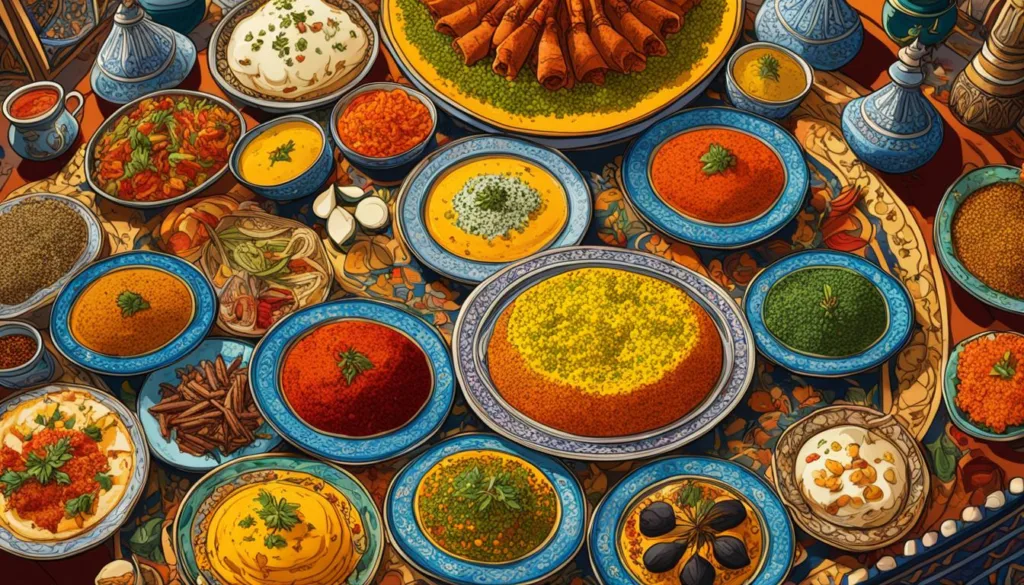
Below is an illustrative guide to the essential spices and select foundational ingredients integral to Persian kitchen compositions, offering insight into the artistry of flavor balance and health principles in Persian food recipes.
| Spice/Herb | Taste Profile | Health Aspect (Hot/Cold) | Common Use |
|---|---|---|---|
| Saffron | Earthy and Floral | Hot | Rice, Desserts |
| Cumin | Warm and Pungent | Hot | Stews, Soups |
| Turmeric | Bitter and Earthy | Warm | Marinades, Rice |
| Cardamom | Aromatic and Sweet | Warm | Tea, Desserts |
| Cinnamon | Sweet and Woody | Hot | Stews, Pastries |
| Dried Mint | Cooling, Herbaceous | Cold | Sauces, Yogurts |
| Lamb | Rich and Savory | Warm | Kebabs, Stews |
| Rice (Chelow, Zereshk Polo) | Subtly Sweet, Nutty | Neutral | Side Dish, Main Course |
| Walnuts | Rich and Bitter | Hot | Fesenjan, Sauces |
Each ingredient’s nature and flavor profile enhance the Persian cuisine exploration, creating a culinary tapestry rich in tradition and taste, true to the core of an Iranian Culinary Guide.
Exploration of Traditional Iranian Dishes
Iran’s rich culinary heritage presents a palette of tastes which are deeply integrated into its culture and customs. An exploration of Traditional Iranian dishes unlocks a universe of savory stews and grilled delights that represent the heart of Iranian hospitality. Among these, the renowned stew, Gheimeh, combines tender meat, split peas, and tomatoes topped with crispy potatoes, demonstrating the intricacy of Persian food recipes. The vegetarian favorite, Ghormeh Sabzi, with its lush greens and aromatic herbs, offers an insight into Iran’s love affair with flavor and zest.
Each regional specialty reflects the local terroir, from Ash-e Reshteh’s comforting noodle soup in the north to the herbaceous notes and tangy accents in southern khoreshts. With every bite, these recipes from the Iranian Culinary Guide transcend mere nourishment, becoming storytelling vehicles that evoke the nation’s history and its generous spirit.
Through a symphony of spices and a harmony of textures, traditional Iranian cuisine presents an indulgence that pleases the palate and warms the soul.
Integration of regional produce and the expertise of local cooking methods imbue dishes like Chelo Kabab with a sensation that’s both novel and nostalgic, encapsulating centuries-old practices that persist in modern Iranian tables. Communal and celebratory events are seldom seen without the likes of these dishes adorning the spread, making them more than just meals—they are a feast for the senses and the focal point of togetherness.
- Savory Stews – Richness in Every Spoonful
- Grilled Magnificence – The Sizzle of Chelo Kabab
- Vegetarian Wonders – The Herbaceous Delight of Ghormeh Sabzi
- Regional Specialties – A Bounty of Local Ingredients and Techniques
Indeed, diving into traditional Iranian dishes is akin to partaking in a historical journey across the provinces of Iran, where food artistry is intimately tied to the collective identity and cultural pride of its people. A journey through Persian food recipes is more than a mere dining experience; it is a voyage through time, senses, and soul.
A Gastronomic Voyage Through Iranian Stews and Kebabs
Iran’s rich tapestry of flavors is a testament to its vibrant and historical culinary culture. Particularly, traditional Iranian dishes like stews and kebabs offer a window into the heart of Persian food recipes. These delicacies are not just meals but stories told through generations, each with a distinct taste and a connection to the Iranian way of life. The best Iranian restaurants often pride themselves on these staple dishes, revealing the diverse palates and culinary skills present in Persian cuisine exploration.
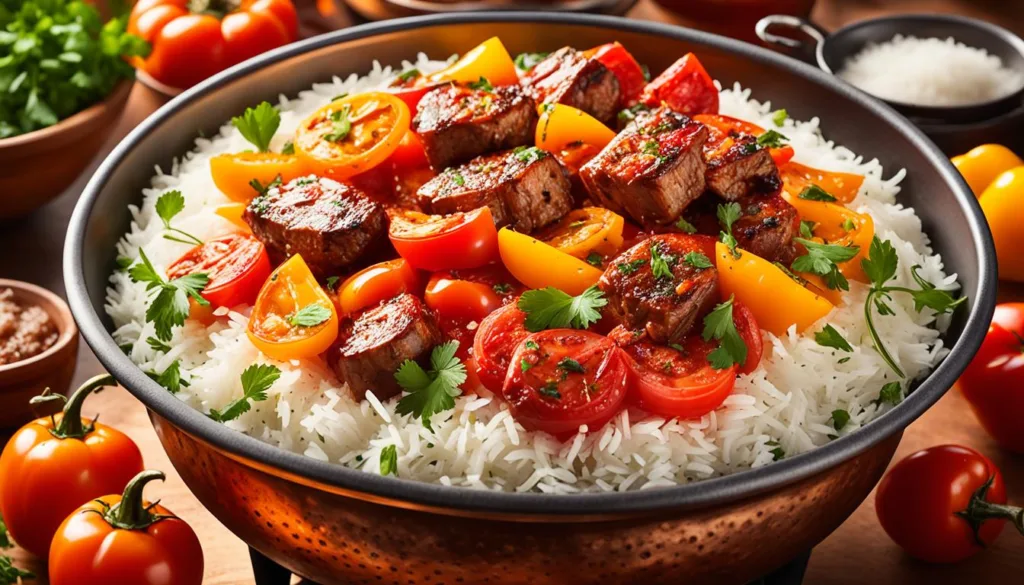
The Richness of Gormeh Sabzi and Fesenjan in Persian Cuisine
The stewed Gormeh Sabzi presents a concert of greens and flavors. This hearty delight is a symphony of parsley, cilantro, chives, and fenugreek, alongside the substance of kidney beans, simmering together with the tartness of dried limes. Crafted in homes and lauded in the Iranian Culinary Guide, Gormeh Sabzi is a representation of the Iranian spirit. Fesenjan, on the other hand, is a luxurious stew, thick with ground walnuts and sweetened by pomegranate molasses. This dish, perfected over centuries, carries the warmth of home, making it a sought-after recipe in Persian food recipes.
The Sizzling Array of Chelo Kebab Varieties
Chelo Kebab, Iran’s answer to the unending search for the perfect grilled dish, is a celebration of flavors. The bedrock of this iconic dish is the meat—lamb, chicken, or beef—meticulously marinated and then grilled, resulting in a sizzle that calls out to the taste buds of food enthusiasts. Here’s a glance at some popular Chelo Kebab variations found across the best Iranian restaurants:
| Type of Chelo Kebab | Primary Meat | Accompaniments | Distinctive Spice Blend |
|---|---|---|---|
| Kebab Barg | Tenderized Lamb Fillet | Buttered Saffron Rice, Grilled Tomatoes | Saffron, Black Pepper, Onion and Garlic Marinade |
| Kebab Koobideh | Ground Lamb or Beef | Saffron Rice, Sumac Onion Mixture | Sumac, Turmeric, and Parsley |
| Joojeh Kebab | Chicken marinated in Lemon and Onion | Rice, Barberries, and Yogurt | Lemon Zest, Saffron, and Thyme |
Each variety offers a unique perspective on Persian grilling techniques, incorporating a blend of spices and long-standing traditions. The result is an enthralling Persian cuisine exploration, where each morsel speaks to the country’s rich gastronomy and the skilfulness behind Iranian culinary guides.
Delighting the Senses: Iranian Rice Dishes
The heart of Iranian culinary traditions lies not only in their flavorful kebabs and opulent stews but also in the varied and richly layered Traditional Iranian dishes centered around rice. Essential to any Persian cuisine exploration is an understanding and appreciation of rice dishes, which hold an esteemed place at the Persian table. Each grain tells a story, capturing the essence of the nation’s profound cultural traditions.
Berenj, the Persian term for rice, is elevated to the realm of art in Iranian gastronomy. Key to this elevation is the masterful technique of creating Tahdig, the golden, crispy crust at the bottom of the pot, which reflects the skill and patience of the cook. As the centerpiece of any meal, the glory of Tahdig cannot be overstated, with its buttery crunch providing a perfect foil to the soft, fluffy grains above.
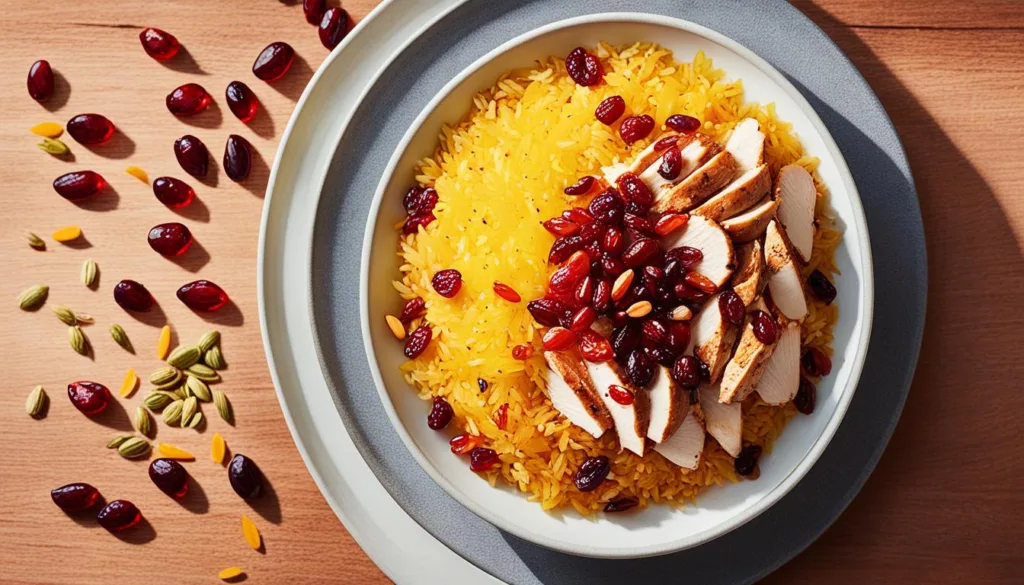
Among the most beloved rice dishes is Zereshk Polo, a fragrant symphony of rice, saffron, barberries, and sometimes nuts, offering a taste sensation with each spoonful. The sour tang of barberries contrasts exquisitely with the natural sweetness of saffron-infused rice, providing an experience that is at once luxurious and comforting.
Iranian rice dishes are a convergence of mastery and tradition, unfolding a world where every morsel is infused with history and care.
The art of rice preparation in Iran is often associated with social occasions and cultural significance, turning the simple act of eating into a celebratory communal statement. To fully grasp the impact of these dishes in Persian culture, one must delve into the meticulous crafting of these culinary masterpieces.
- Chelow: The simple, yet elegant, steamed white rice that forms the foundation for many a meal.
- Baghali Polo: A glorious mix of rice with dill and fava beans, typically served alongside succulent lamb shanks.
- Tahchin: An elaborate rice cake including yogurt and saffron, layered with chicken or lamb, and baked to create a savory, golden crust.
Rice dishes in Iran are not merely a means of sustenance but an inspired tradition that has been perfected over generations, flourishing under the auspices of family get-togethers and special festivities.
Sweet Endeavors: A Taste of Iranian Desserts
Delving into the world of Iranian Desserts is akin to exploring a treasure trove of taste and tradition. Luscious Persian sweets are deeply ingrained in Iranian culinary traditions, where centuries of confectionery craft have perfected the art of dessert-making. This delightful journey unveils a variety of tastes that are as rich in history as they are in flavor.
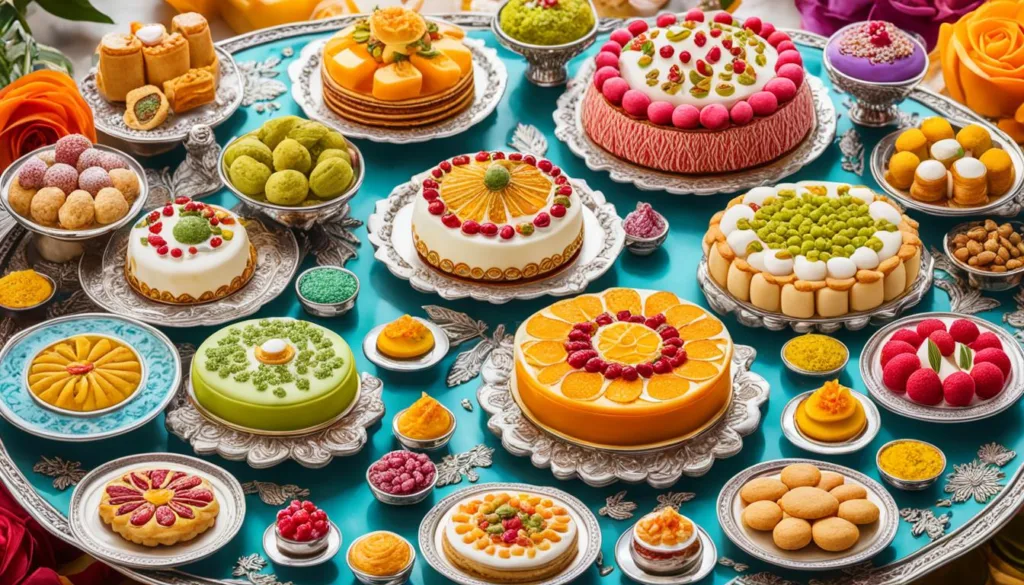
Zoolbia and Bamieh to Baklava: A Confectionery Delight
The candy-coated threads of Zoolbia and the small, crunchy Bamieh are irresistible companions often enjoyed during the month of Ramadan. Drenched in light syrup, they offer a textural symphony that complements the festivity. Not to be overlooked, the multilayered Baklava, with its flaky pastry and dense filling of chopped nuts, sweetened with honey or syrup, represents the intricate and opulent aspect of Persian sweets.
Fereni and Bastani: Iranian Treats Infused with Saffron and Rosewater
Bringing a delicate balance to the sweet journey, Fereni’s velvet creaminess and Bastani’s cold satisfaction are both tinged with the essence of saffron and rose, hallmark flavors of the Persian dessert repertoire. Bastani, in particular, showcases the perfection with which Iranians meld familiar ice cream with traditional tastes, creating a chilled dessert scattered with pistachios and flecks of heavenly spices.
The mastery in crafting these delectable Iranian Desserts lies not just in their exquisite taste but also in their representation of the loving labor that goes into preserving and continuing Iranian culinary traditions. Each sweetened morsel is an ode to the culture’s rich history and a testament to the inherent generosity found within the Persian approach to sharing meals and moments.
The Vibrant Iranian Street Food Scene
Strolling through the bustling streets of Iran’s cities, one encounters the beating heart of Iranian Street Food. This immersive experience offers an interactive journey flavored with the cultural authenticity that defines a true Persian culinary adventure. From the corners of Tehran to the alleys of Shiraz, food stands and mobile vendors beckon with their generous displays of traditional fare, ready to take your senses on an exploration of taste and tradition.
Imagine the scent of Barbari bread, its crusty exterior crackling warmly as it’s pulled from the oven. Nearby, the harmonious mixture of herbs and beans fill the air as a pot of Ash Reshteh simmers patiently, waiting to offer comfort to those who seek the flavors of home-cooked Persian food recipes. Each dish is a chapter in the culinary narrative of Iran, revealed in bites and savors under open skies.
Best Iranian restaurants may showcase how the traditional cuisine can be adapted to the fine dining experience, but it is in the streets where the true unvarnished flavors flourish. Here, one can witness the genuine spirit of Persian cuisine, where recipes passed down through generations are shared freely with locals and visitors alike.
- Sangak – An integral part of the Iranian diet, this whole grain sourdough flatbread is often sprinkled with sesame seeds, providing a nutty and satisfying crunch.
- Faludeh Shirazi – A dessert originating from Shiraz, characterized by its frozen vermicelli noodles in a semi-frozen syrup made from sugar and rose water.
- Kebab – No Iranian street food scene would be complete without the presence of kebabs; juicy, marinated meats grilled to perfection over open flames.
This vibrant street food scene offers more than just sustenance; it provides a communal table to which all are invited. In this dynamic exchange between vendor and guest, barriers are broken down and friendship formed, one delicious bite at a time. Whether you seek the homeliness of a stew or the thrill of a kebab, the streets of Iran promise a feast of flavors that are as rich in history as they are in taste.
Iranian Cuisine: A Reflection of Varied Geographic and Cultural Landscapes
The unique beauty of Iranian cooking techniques and Traditional Iranian dishes lies in their profound connection with the various geographic and cultural landscapes of the region. From the Caspian Sea’s moist, verdant shores to the sunbaked terrains of the Persian Gulf, the diversity of Iranian topography is richly mirrored in its culinary tradition. This remarkable variety not only enriches the Persian cuisine exploration but also distinctly colors the gastronomic map with regional specialties exclusive to each locale.
From the Lush North to the Balmy South: Regional Food Specialities
In the northern territories, green foliage and abundant rainfall nurture the growth of unique herbs and vegetables, which are artfully weaved into local cuisine. The coastal cities teem with an impressive variety of seafood, each prepared with indigenous spices and techniques that heighten their natural flavors. Conversely, the southern regions harvest the rewards of their balmy weather and proximity to the sea by offering an array of delectable seafood dishes. Each plate, a narrative of the place it hails from, is a testament to Iran’s broad culinary spectrum.
Unveiling the Culinary Secrets of Gilaki Cuisine Recognized by UNESCO
Gilan’s provincial kitchen is a particularly illustrious example of Iran’s culinary wealth, so much so that its Gilaki cuisine has been acknowledged by UNESCO for its unique gastronomic culture. Traditional Iranian cooking techniques are at the core of this recognition, encompassing over 170 Gilaki dishes. Local staples like the eggplant-based Mirza Ghassemi and the herby Baghali Ghatogh highlight the verdant grace of this northern province. Many Gilaki dishes are inherently vegetarian, enticing not only the local populace but also international visitors on the lookout for the best Iranian restaurants imparting authentic traditional experiences.
- Persian cuisine exploration invites you to a journey through Iran’s diverse regional tastes.
- Best Iranian restaurants harnessed these cooking techniques to offer a piece of Iran’s gastronomic story.
- Irresistible traditional Iranian dishes provide a mouthful of the country’s rich, cultural tapestry.
Conclusion
Iranian dishes, with their scents of saffron and sounds of sizzling kebabs, have intrigued and delighted food enthusiasts the world over. This culinary guide has attempted to unravel the complex tapestry that is Persian cuisine—a narrative rich in history, taste, and cultural significance. Traditional Iranian dishes are not just recipes passed down through generations; they are invitations to a grand table set by a culture that prides itself on hospitality and communal joy.
The Universal Appeal of Iranian Dishes: An Invitation to Global Foodies
The Persian food recipes we’ve explored are an ode to Iran’s diverse palate, offering a universally appealing bouquet of flavors. These dishes are a feast for the senses that capture the essence of Persian cuisine exploration. Whether savoring the complex layers of a Gormeh Sabzi or the sweet subtlety of a Shirin Polo, the best Iranian restaurants and home kitchens alike reflect a legacy that transcends borders, drawing food lovers into a deeply rooted gastronomic experience.
Welcoming Gastronomic Experiences: Iran’s Open Invitation to its Culinary World
Iran’s open invitation to its vibrant culinary world is ultimately a journey that nourishes more than just the stomach—it is sustenance for the soul. As we’ve traversed from the rich stews to the delectable rice dishes, the essence of Iranian culinary traditions has revealed itself as both an ancient craft and a continuously evolving art. The promise of these flavorful experiences beckons global gastronomes to not only indulge in, but also embrace, the Iranian way of life—one meal at a time.
FAQ
What makes Iranian cuisine unique?
Iranian cuisine stands out for its mesmerizing blend of flavors and traditions shaped by various influences, a strategic use of spices and herbs, and a rich history that reflects in its diverse dishes. Every meal is not just about sustenance but is treated as a communal ritual where sharing food is an act of care and affection.
Can you explain the social importance of food in Iranian culture?
In Iranian culture, food goes beyond mere sustenance and is deeply intertwined with customs, hospitality, and social gatherings. The practice of Ta’arof, which emphasizes abundance and politeness during meals, and the communal dining arrangements mirror Iran’s cultural ethos of generosity and community.
What are some traditional spices used in Iranian cooking?
Traditional Iranian cooking involves a wide array of spices such as saffron, cumin, turmeric, cardamom, cinnamon, and dried mint. These spices contribute to the aromatic palette that is characteristic of Persian cuisine.
What are some staple ingredients found in Persian kitchens?
Staple ingredients include rice (such as Chelow and Zereshk Polo), meats (especially lamb, as seen in various kebabs and stews), alongside yogurt, chickpeas, tomatoes, onions, garlic, and a variety of nuts. These form the backbone of the enticing flavors in Iranian dishes.
How do the principles of hot and cold nature influence Iranian cooking?
The concept of hot and cold natures in ingredients, shaped by Avicenna’s teachings, is key in Persian culinary philosophy. It categorizes foods based on their effects on the body’s metabolism and strives to achieve a balance, promoting not just flavor but also bodily health and well-being.
Can you name some traditional Iranian dishes?
Iran’s culinary landscape includes dishes like Gheimeh, Ash-e Reshteh, the famous Chelo Kabab, and vegetarian options like Ghormeh Sabzi, incorporating regional specialties and local ingredients, each with its unique story and flavors.
What can I expect from a typical Iranian stew or kebab?
Iranian stews like Gormeh Sabzi and Fesenjan are rich and full of flavor, featuring blends of herbs, beans, and meats in savory sauces. Kebabs, such as Chelo Kebab, offer masterfully grilled meats served with saffron-infused rice, symbolizing the skill and flavor diversity in Iranian cookery.
How are rice dishes prepared and appreciated in Iran?
Iranian rice dishes, from Zereshk Polo to Tahdig, are aromatic and complex, often garnished with spices, barberries, and nuts. Rice preparation is considered an art form with cultural significance, indicating the occasion’s importance.
What variety of desserts can I find in Iranian cuisine?
Iranian desserts range from syrupy Zoolbia and Bamieh to nut-filled Baklava, each offering a sweet end to the meal. Ingredients like saffron and rosewater deeply enrich desserts such as Fereni pudding and Bastani ice cream, creating a unique blend of sweet and aromatic flavors.
What is the street food scene like in Iran?
The Iranian street food scene is dynamic and diverse, offering everything from the freshly baked Barbari bread to hearty bowls of Ash Reshteh. Street vendors provide a tasting journey through the everyday flavors and culture of Iran.
How do regional differences influence Iranian cuisine?
The geographic and cultural diversity of Iran, from lush northern provinces like Gilan to the southern coasts, influences the variety of dishes and ingredients. Local climate and resources dictate regional culinary specialties, contributing to the country’s rich gastronomic tapestry.
What is unique about Gilaki cuisine?
Gilaki cuisine, from Iran’s northern province of Gilan, has gained UNESCO recognition for its rich gastronomy that emphasizes local produce and vegetarian-friendly options such as Mirza Ghassemi and Baghali Ghatogh. Its deep-rooted cooking methods and creativity make it a treasured part of Iran’s food heritage.
What makes Iranian dishes globally appealing?
The rich history, diverse flavors, and cultural significance of Iranian dishes have a universal appeal, inviting food lovers worldwide to explore its unique gastronomic treasures. From the fragrant stews to the sumptuous kebabs, Iranian cuisine has something to intrigue and delight any palate.
How does Iranian food culture welcome newcomers?
Iranian food culture extends a welcoming hand through shared meals and exploration of traditional and street food delights. The inviting nature of Iranian meals and the rich culinary experiences they offer aim to nourish not just the body but also the soul of anyone who partakes in them.
